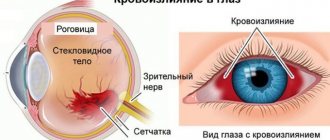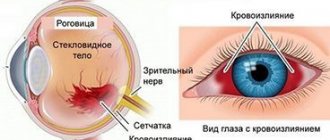Very often, redness of the eyes is called “bursting” of blood vessels, although this is far from true. Normal redness of the eyes is associated with general or local dilation of the vessels of the conjunctiva of the eye.
When a vessel in the conjunctiva of the eye ruptures, hemorrhage occurs in the form of a red or scarlet spot on the whites, which does not go away quickly and takes a long time to resolve, 1-2 weeks.
There are only a few people who have not experienced redness of the eyes. Why do blood vessels burst in the eyes? Is this dangerous, and how can I prevent the problem from occurring?
First, let's look at the reasons. The eye is penetrated by many vessels and capillaries that supply the tissues of the eyeball with oxygen.
Causes of red blood vessels in the eyes
There are many reasons that cause red eyes. These include various inflammations, infections, and excessive visual stress. The eyes turn red when wearing contact lenses if you do not follow the rules of disinfection, the regimen and timing of their wearing. The vessels may become visible if dry eye syndrome develops - with such an ophthalmological problem, a lack of tear fluid is detected, which negatively affects the condition of the capillaries.
Why eyes turn red - reasons:
- colds that occur with fever;
- dry eye syndrome when wearing contact lenses;
- increased visual stress;
- ophthalmological infectious diseases;
- allergic rhinitis, conjunctivitis;
- hypertension - due to increased pressure, blood vessels increase in volume;
- intraocular pressure, glaucoma;
- reaction to the use of medications;
- foreign body, dust, sand getting into the eye;
- hemorrhage as a result of blockage of the retinal veins, its detachment.
Reducing the amount of moisture in the eyes can cause the spread of viruses and infections, and inflammation of the conjunctiva. A healthy person has all the mechanisms to protect against such exposure. Tears contain lysozyme, a protein that has antimicrobial and antiviral effects. If there is little tear fluid, for example, due to working in rooms with functioning climate control equipment, or with increased visual stress at the computer, this can lead to redness of the eyes.
You can eliminate visible eye vessels with the help of whitening drops, which relieve redness and swelling of the conjunctiva, having a vasoconstrictor effect. But the problem will arise again if you ignore the very cause of red eyes.
And this reason may not be harmless at all, because some diseases of the visual organs require serious treatment due to the rapid development of dangerous symptoms. Thus, constantly increased intraocular pressure in glaucoma triggers irreversible processes. The earlier the disease is diagnosed, the better the prognosis.
Symptoms of vascular diseases of the eye
- Thrombosis of the branches or central retinal vein.
- Disruption of blood flow in the branches or in the central artery of the retina.
- Papillopathy.
- Ischemic neuropathy (anterior and posterior).
- Ocular ischemic syndrome.
When blood flow is disrupted, hemorrhage in the macula, edema, or blood flow in the optic nerve is disrupted, vision loss occurs.
When changes in blood flow do not affect the macula area, it manifests itself only as disturbances in peripheral vision.
Factors that cause red eyes
Redness of the whites of the eyes is a common problem, and this makes it seem insignificant. Many people notice that red streaks appear on the whites after a sleepless night, excessive consumption of strong alcoholic beverages, as a result of visual fatigue, and prefer to do nothing to eliminate such symptoms. Meanwhile, alcohol dilates blood vessels, increases blood flow, and then the vessels narrow again and the outflow of blood becomes more difficult, so the capillaries become overfilled with blood, which negatively affects the condition of their walls. The same processes occur when smoking in an unventilated room: blood vessels narrow, blood flow decreases, and dryness appears.
Negative factors affecting the condition of the blood vessels of the eyes:
- external irritants: tobacco smoke, smog, dust, windy weather;
- lack of sleep, bad habits;
- low-quality cosmetics, aerosols (irritation is caused by preservatives, lanolin, zinc oxide, titanium dioxide);
- washing, water procedures using chlorinated water - chlorine disrupts the microflora of the conjunctiva and lacrimal ducts;
- wearing contact lenses with low oxygen permeability parameters - such products prevent the passage of oxygen to the cornea, which affects the health of the visual organs.
To understand why the eyes turn red, you need to know what capillary damage is. The blood vessels do not burst, although many people think so when they see large red islands on the whites of the eyes. Simply due to the dilation of blood vessels, the blood in them becomes visible due to the fact that the walls of the capillaries themselves become thinner. Also, the vessels turn red due to the spread of infection, for example, with viral or bacterial conjunctivitis.
In this case, the fight against redness will be carried out in combination with therapeutic measures aimed at relieving inflammation and eliminating microbes and viruses.
Classification
In addition to unilateral and bilateral pathology, there are three types of angiopathy, which differ in the mechanism of development, age and physical condition of the patient:
- Retinal angiopathy of prematurity is a rare and at the same time the safest type of pathology. It is diagnosed in children who have suffered birth injuries or gone through protracted labor in the first weeks of life. The essence of the changes is the narrowing of the capillaries in the fundus. Over time, microcirculation is restored.
- Angiopathy in pregnant women is a condition caused by changes in hormonal levels and an increase in the total volume of circulating blood. It is diagnosed in the second half of gestation and is expressed by weakening of the vascular walls. During childbirth, retinal detachment or rupture may occur.
- Juvenile angiopathy is a pathology that is diagnosed in patients at a young age. The essence of the changes is inflammation of the capillaries and their destruction. This form of the disease most often ends with profuse hemorrhage under the retina or into the vitreous body. In severe cases, it can lead to instant loss of vision and cataracts.
- Diabetic angiopathy is a pathology accompanying advanced diabetes, which is expressed by a weakening of blood flow in the capillaries, the development of retinal ischemia and its gradual degeneration.
- Hypertensive angiopathy is a condition in which excessive dilatation of the vessels of the fundus occurs, which causes pinpoint hemorrhages, and then clouding of the vitreous body.
- The traumatic form of the pathology is diagnosed in patients with osteochondrosis of the cervical back. Accompanied by weakening of microcirculation and thrombosis of the ocular vessels.
For each form of pathology, specific treatment is used, so during the diagnostic process it is important for the doctor to establish the type of disease.
How to remove red blood vessels in the eyes?
You can remove visible red blood vessels in the eyes, if the redness is not associated with colds and ophthalmological diseases, by using anti-inflammatory eye drops. If your eyes are red due to bacterial conjunctivitis, you will need antimicrobial drugs and broad-spectrum antibiotics. Red eyes caused by viruses can be treated with antiviral medications. Drugs such as Zovirax, Lavomax, and Acyclovir are effective against viruses. If the causes of red blood vessels are allergic in origin, you will need antihistamines, which are individually selected by the doctor and written out a prescription. Nowadays, second-generation drugs, without sedation, are more often used.
What else is used for red blood vessels in the eyes? How can you quickly get rid of redness? Redness that appears due to severe fatigue and eye strain, unfortunately, does not go away quickly, but there are effective measures that, when used in complex therapy, can help get rid of visible blood vessels.
Improvement of eyes with weak blood vessels prone to redness:
- the use of eye drops with vitamins that improve nutrition and metabolism in eye tissues, activating recovery processes;
- a course of vitamins for vision - “Taufon Tabs Lutein” with plant carotenoids is suitable, they are recommended for increased visual stress, when working at a computer, impaired twilight vision, constant eye fatigue (prescribed by a doctor);
- massage to relieve swelling of the eyelids - lightly stroking the eyelids with your fingertips improves blood circulation, which helps relieve eye strain;
- whitening vasoconstrictor drops - short-term use of such drugs is allowed when it is necessary to quickly remove redness.
Red eye syndrome occurs when the elasticity of blood vessels decreases and their permeability increases.
To get rid of the problem for a long time, it is necessary to strengthen the blood vessels of the eyes, take medications prescribed by the doctor, and also eliminate the causes of the pathology that affect the appearance of red blood vessels. Red veins are always a clear signal from the body about problems in the blood supply system of the eyeball.
When to go to the doctor?
Ideally, if a vascular structure in the eye has burst, you should immediately seek help from an ophthalmologist. But when this is not possible and the suspected causative factor is known, you can simply observe the hemorrhage. If it decreases, there is most likely no cause for concern. When the hemorrhage does not go away after a week, you need to seek medical help.
Dynamics of subconjunctival hemorrhage with a small size
There are situations when a burst vessel can pose a health hazard:
- if the hemorrhage appears after severe trauma to the eyeball or head;
- frequent episodes of hemorrhages without objective reasons, in this case a disease may develop in the body that contributes to the fragility of blood vessels;
- if, in addition to hemorrhages, there are other signs of increased bleeding, for example, from the nose, gums.
You should definitely seek help if, in addition to hemorrhage, you are concerned about other ophthalmological symptoms: decreased visual acuity, loss of visual fields, the appearance of dots or blurred vision, pain, pain, discharge from the eyes.
Strengthening eye blood vessels
The choroid of the eye is located between the sclera and the retina. Capillaries form a dense vascular network, which becomes visible only in the presence of pathological changes in the vessels and inflammation of any part of the eye. Increased vascular permeability can be caused by infections, fungi, viruses and bacteria. Vessels also dilate due to the action of histamine (with allergies). The result of this effect is red blood vessels in the eyes.
Remember that ignoring disturbances in the blood supply system of the visual organs can lead to dysfunction of the eye structures, decreased visual acuity, especially if redness is accompanied by pain, inflammation, and decreased visibility. Red blood vessels in the eyes become visible due to changes in the strength and elasticity of the capillary walls.
How to strengthen the blood vessels of the eyes:
- taking vitamin complexes with zinc, lutein, copper, iron;
- proper, well-balanced nutrition (eating foods high in vitamins C, K, A, E);
- eye drops, the action of which is aimed at strengthening the walls of blood vessels, improving metabolic processes, stabilizing cell membranes, reducing intraocular pressure, increasing tissue resistance to oxygen deficiency, regulating the biosynthesis of proteins involved in blood clotting (Taurine, Oftagel, Vizin) , "Emoxipin", "Oftan Katahrom").
To strengthen the blood vessels of the eyes, ophthalmologists prescribe drugs with a complex effect, which not only improve blood flow to the organs of vision, but also have an angioprotective effect, strengthen the vascular wall, and eliminate intraocular hemorrhages. If you urgently need to remove redness from the eyes, you can use whitening drops “Okumetil”, “Betadrin”, etc., just use them with caution.
Venous system of the eye
The venous system ensures the outflow of blood from the eye tissues. Its main link, the central retinal vein, is occupied by the outflow of blood from the structures supplied by the artery of the same name. It then joins the superior ophthalmic vein at the cavernous sinus.
The vorticose veins are involved in draining blood from the choroid. Four of them drain blood from the same area of the eye, then the two upper veins merge with the superior ophthalmic vein, and the two lower ones - with the lower one.
In all other respects, the venous outflow of the organs of the orbit and eye repeats the arterial blood supply, occurring in the reverse order. The bulk of the veins flow into the leaving orbit through the superior orbital fissure, the superior ophthalmic vein, the rest flow into the inferior ophthalmic vein, which usually has two branches. One of them is connected to the superior ophthalmic vein, the path of the second lies through the inferior orbital fissure.
The peculiarity of venous outflow is the absence of valves in the veins and a fairly close connection between the venous systems of the eyes, face, and brain, which poses a serious danger to life if purulent inflammation occurs.
Whitening eye drops: application features
Drops for whitening proteins do an excellent job with the aesthetic task of removing red blood vessels and making the look clean and radiant. Such preparations not only eliminate redness, but also lighten the entire protein if it has a dull, yellow color. The effect of bleaching drops is vasoconstrictive, so their long-term use is not recommended. They can help if your eyes are red due to allergies, fatigue, and you need to look cheerful and fresh.
Whitening drops - action:
- have a slight anti-inflammatory effect;
- remove redness of the eyes, swelling;
- moisturize the eyes;
- The aesthetic effect is quick; within an hour after using the drug, the eyes will brighten.
You should not use whitening drops for more than one week, otherwise addiction will occur and they will no longer be effective. Be careful, these drugs have contraindications, so be sure to consult with your doctor.
Red blood vessels in the eyes: treatment with folk remedies
Folk remedies can really help if the eyes are red and look tired, but pharmaceutical drugs are not at hand. But use such remedies only when prescribed by a doctor. And you are sure that there is no inflammation, infection, and the redness of the eyes is caused only by fatigue and overexertion, but not by an exacerbation of ophthalmic diseases.
Folk remedies for red eyes:
- herbal compresses from chamomile, basil, blue cornflower, flax seeds, oak bark - it is better to use cool liquid or decoctions at room temperature, this is effective for relieving swelling;
- tea lotions - you can use black or green tea bags for compresses;
- applying raw potato circles to the eyelids for 20-30 minutes;
- washing the eyes with cucumber water (prepared from the peel of fresh fruits, which is poured with boiling water and infused for half an hour).
Be especially careful with recipes based on honey and other bee products, which can cause an unwanted allergic reaction even in people who are not prone to allergies. Give preference to medications prescribed by an ophthalmologist. They are safe, and most importantly, they have a quick effect.
Treatment of scleritis
The etiology (causes), localization, severity, and characteristics of the course of the disease determine the therapeutic strategy. Thus, a viral infection is stopped through immunostimulation and immunomodulation, a bacterial infection - with antibiotics, allergic inflammation - with antihistamines.
Glucocorticoid drugs, corticosteroid drops and ointments are widely used locally, and sometimes non-steroidal anti-inflammatory drugs are used orally. During the recovery stage, physiotherapeutic procedures are almost always prescribed.
In the most serious cases, for example, with abscesses and/or the risk of perforation of the sclera, ophthalmic surgery is indicated, incl. for scleral tissue transplantation.
Prevention
If redness of the eyes was associated only with increased visual stress and fatigue, and not with the development of an infectious disease, if ophthalmological pathologies were not identified, then preventive measures will help prevent the occurrence of such disorders in the future. Eyes turn red due to hypertension, lack of sleep, unhealthy lifestyle, negative environmental factors (wind, tobacco smoke, working climate control equipment, etc.).
Lack of oxygen also has a negative impact on eye health. There are many reasons why there is not enough oxygen in the tissues: non-compliance with wearing contact lenses, unfavorable environmental conditions, poor circulation. All this affects the general health of a person and the condition of his eyes, which, due to lack of oxygen, quickly get tired, turn red, and swell. To completely get rid of red eye syndrome, it is necessary to follow a set of preventive measures:
- normalization of sleep, rest and work patterns - during sleep, the visual organs rest and recover, so it is important to sleep for at least 7-8 hours;
- visual gymnastics - exercises are aimed at improving metabolism, normalizing blood flow, strengthening the vascular system of the eye;
- the use of moisturizing drops for increased visual stress, wearing contact lenses - choose moisturizing preparations without preservatives, with hyaluronic acid, to create a protective tear film on the surface of the eye, for example, Hilo-Komod drops;
- physical activity, healthy lifestyle - performing physical exercises helps saturate all tissues with oxygen, which has a positive effect on the condition of the blood vessels in the eyes, strengthens them;
- eye protection from ultraviolet radiation - if you wear glasses or lenses, choose products equipped with protective filters, and always wear sunglasses in sunny weather;
- control of visual stress - take breaks while working at the computer, do not let your eyes become overstrained.
It will be much better if you organize your workspace correctly. The better the lighting, the less strain will be on the visual organs. Do not use products for hygiene procedures that may irritate the mucous membrane of the eyes.
Proper, balanced nutrition will also help. Your daily diet should include vegetables and fruits, berries and other foods high in vitamins that are good for the eyes. Give preference to leafy greens, citrus fruits, lean meat and sea fish, fruit drinks and compotes, try to consume less foods with preservatives.
Read also
Blindness
Vision is a unique gift that nature has given us.
We can truly appreciate it only when we lose. With a number of diseases, vision loss can sometimes decrease to almost complete blindness. Often... Read more
Contact lenses/contact correction
Vision is one of the senses through which we learn about the world around us. Good vision is essential for a high quality of life. The most important characteristic in diagnosis is the acuity...
More details
Partial optic atrophy (PANA)
Vision is the most important function in human life. We receive 70% of information from the world around us through vision. The optic nerve is one of the most important elements of the organ of vision. It is through...
More details
Myopia
Vision plays a huge role for a person. Through the eye we experience the entire amazing and diverse world. A person receives 80-90% of information from the surrounding world through vision. Therefore, a huge tragedy...
More details
Allergic dermatitis
What is allergic contact dermatitis? Anyone has ever experienced skin symptoms after using various skin care products, shower gel or shampoo. Such…
More details









